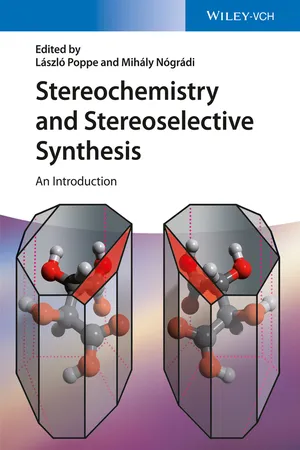Chemistry
Skeletal Formula
A skeletal formula is a simplified way of representing organic molecules in chemistry. It uses lines to represent carbon-carbon bonds and omits carbon and hydrogen atoms, unless they are bonded to heteroatoms or functional groups. This condensed notation helps to show the structure and connectivity of the atoms in a molecule.
Written by Perlego with AI-assistance
Related key terms
Related key terms
1 of 4
Related key terms
1 of 3
3 Key excerpts on "Skeletal Formula"
- eBook - ePub
A-Level Chemistry's Best Kept Secrets!
What Top Students Know That You Don't
- K W David Tan, Leonard Pereira(Authors)
- 2018(Publication Date)
- WS EDUCATION(Publisher)
SECTION 3
ORGANIC CHEMISTRY
Passage contains an image
SECTION 3.1A
INTRODUCTORY — STRUCTURE AND BONDING
Drawing Skeletal Formula
A Skeletal Formula is a type of structural formula that serves as a shorthand representation of a molecule’s bonding. In a Skeletal Formula, all the hydrogen atoms are removed from carbon chains, leaving just a carbon skeleton with functional groups attached to it.✓ Comment: Drawing and interpretation of skeletal structures takes time and practice. Although Skeletal Formula may take some getting used to, it is a quick and easy way to represent the structure of a molecule. For examination questions that require candidates to draw all the possible structures based on the given chemical formula, knowledge on Skeletal Formula could prove very useful and save valuable time.Example 1
Draw the Skeletal Formulae of the following compounds.(a) CH3 CH2 CH2 CH3(b) CH3 CH2 CH2 CH2 Cl(c) CH3 CH2 CH2 CH2 OH(d) CH3 CH2 CH2 CH2 NH2(e) CH3 CH2 CH2 COOH(f) CH3 CCCH3Solution
Drawing Structural Formulas from Names
Step 1: Draw and number the carbon atoms in the parent chain.Step 2: Draw the principal functional group.Step 3: Draw the substituent(s).Step 4: Fill in the remaining hydrogen atoms.✓ Comment: This is a very important skill that all students must have. In some questions on structure elucidation, the names of the compounds are given and candidates are expected to know their structural formulas.For a start, here are the names of a few simple organic compounds:(a) 2,3-dibromobutane(b) 2-methylpentan-1-ol(c) 2,2-dimethylbutaneThe general name structure comprises (i) position(s) of particular substituent, (ii) no. of that substituent (mono, di, tri, tetra, penta, etc.), (iii) name of substituent, (iv) name of longest continuous carbon chain bearing the principal functional group (which may or not be the substituent). Consideration must be made for the priority of the functional group (if there is more than one substituent). - eBook - ePub
Understanding Advanced Organic and Analytical Chemistry
The Learner's ApproachRevised Edition
- Kim Seng Chan, Jeanne Tan;;;(Authors)
- 2016(Publication Date)
- WS EDUCATION(Publisher)
2 can represent more than one compound, and these include the following carboxylic acid and ester:We need to rely on some visuals to depict the arrangement of atoms within a molecule or, in other words, the consitutional/structural formula of an organic compound. In a displayed formula, otherwise known as the full consitutional/structural formula, all the atoms and the bonds between them are shown. One of the displayed formulae for a carboxylic acid with the molecular formula C3 H7 COOH looks like this:A Skeletal Formula is a simplified drawing in the sense that all C−H bonds are not shown and each C−C single bond is depicted as a line “−” with C atoms present, but not shown, at both ends of the line. If heteroatoms (such as O, N, Cl, etc.) are present, their elemental symbol is included to depict the bonding to the carbon skeletal structure. The Skeletal Formula for the same carboxylic acid, C3 H7 COOH, that was discussed above is shown as:There are no hard and fast rules in drawing a consitutional/ structural formula. Basically, a diagram drawn must not be ambiguous. For instance, the following condensed consitutional/structural formulae are valid in depicting the same carboxylic acid molecule:All these structures show the same sequential arrangement of atoms in the molecule when one reads from left to right. However, ambiguity arises when the formula for the acid is written as C3 H7 COOH because it can represent more than one unique compound. The ambiguity resides in the −C3 H7 segment as it can be either one of the following two structures:With all that said, the various types of consitutional/structural formulae mentioned so far only show the connectivity of one atom to another. They do not indicate the actual geometry or bond angles in the molecule. To depict the three-dimensional (3-D) geometry about a particular atom, we make use of the 3-D structural formula which utilizes the following conventions: - eBook - ePub
Stereochemistry and Stereoselective Synthesis
An Introduction
- Mihály Nógrádi, László Poppe, József Nagy, Gábor Hornyánszky, Zoltán Boros(Authors)
- 2016(Publication Date)
- Wiley-VCH(Publisher)
To depict more complex structures (e.g., escitalopram), condensed or Kekulé representations are practically useless, and therefore a combination of linear and stereo representation is recommended. The complete stereostructure of molecules can be best depicted by a simplified representation of 3D structures. In Figure 1.5, two possible modes of representation of molecular models that is, ball and stick and space-filling models are shown. 5 As can be seen with more complex molecules, space-filling models refer to their overall shape, while the details of the structure are less apparent. 1.3 Description of Chemical Structure Chapters of the rules of International Union of Pure and Applied Chemistry (IUPAC) for naming compounds [3] do not give a precise definition of what should be understood under “chemical structure.” Therefore, we define in a general way as chemical structure as it is understood by crystallographers: chemical structure is an accurate description of the spatial arrangement of the constituting atoms (atomic nuclei) in space. The exact spatial arrangement of atoms can be described, for instance, by their Cartesian coordinates. 6 From a structural point of view, however, it is not the absolute position and orientation of the molecule that is decisive; therefore, it is often more useful to describe the relative position of atoms by s.c. internal coordinates 7 (Figure 1.6). Internal coordinates for the description of molecules are the bond lengths (r), the bond angles (α), and the torsion angles (ω). 8 Figure 1.6 Characterization of molecules consisting of two, three, and four atoms with internal coordinates. For the description of molecules containing two atoms (I), besides defining the type of atoms (A, B), it is sufficient to give the bond length as a single internal coordinate
Index pages curate the most relevant extracts from our library of academic textbooks. They’ve been created using an in-house natural language model (NLM), each adding context and meaning to key research topics.
Explore more topic indexes
Explore more topic indexes
1 of 6
Explore more topic indexes
1 of 4


